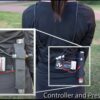University at Buffalo engineers are reporting a new energy dissipation device that they say could have far-reaching applications in transportation safety.
Described in the International Journal of Mechanical Sciences, the device utilizes low-cost metallic materials and a simple design. Unlike conventional sacrificial structural components like car bumpers, it’s designed to be reused after impact.
“Most energy absorbers carrying high stiffness work by crushing or collapsing upon impact. This reduces physical damage to the vehicle, or whatever the absorbers are protecting, but it requires the replacement of internal and external parts following the collision,” says the study’s senior author, Jongmin Shim, Ph.D., associate professor of structural engineering in the UB School of Engineering and Applied Sciences.
“Our structure is unique in that it enables impact energy to detour around the vehicle. It’s comprised of one column with a flange at each end. These flanges have hinges that allow the normally rigid column to snap out of place, which converts external energy into kinetic energy of the disconnected column, eventually protecting the vehicle,” he adds.
Study co-author Seoyoung Heo, Ph.D., is a former graduate student in Shim’s lab.
“The device is engineered to have both high stiffness—the ability to bear loads and resist collapsing—as well as high damping, which means it can dissipate energy,” she says. “Its potential applications are varied, everything from automobiles and ship buffers to helicopters, drones and more.”
The researchers conducted tests of the device, made of steel, on examples measured by centimeters. Because of its simple design and common materials, they say, it could easily be scaled up or down to other dimensions.
Shim and Heo are co-inventors on a provisional patent application filed by UB with the U.S. Patent and Trademark Office for the device. The technology is available for licensing through the UB Technology Transfer office.
Unique technology gives humans a leg up on walking
More information:
Seoyoung Heo et al, Weakening-induced Snap Instability as a Novel Reusable Force Protection Mechanism, International Journal of Mechanical Sciences (2021). DOI: 10.1016/j.ijmecsci.2021.106645
Provided by
University at Buffalo
Citation:
Study: New reusable shock absorber shows promise in lab tests (2021, July 27)
retrieved 27 July 2021
from https://techxplore.com/news/2021-07-reusable-absorber-lab.html
This document is subject to copyright. Apart from any fair dealing for the purpose of private study or research, no
part may be reproduced without the written permission. The content is provided for information purposes only.



